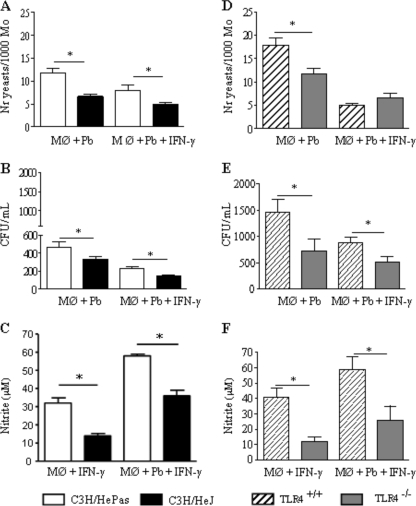FIG. 1.
TLR4 deficiency leads to less-severe fungal infection of macrophages (Mφ) associated with decreased synthesis of NO. The phagocytic and fungicidal abilities of macrophages from mice with defective TLR4 signaling (C3H/HeJ) or defective TLR4 expression (C57BL/6 TLR4−/−) were compared with those of their TLR4-normal controls (C3H/HePas and C57BL/6 TLR4+/+, respectively). (A and D) For phagocytic assays, IFN-γ-primed (20 ng/ml, overnight) and unprimed macrophage cultures were infected with P. brasiliensis yeasts at a macrophage/yeast ratio of 25:1. The cells were cocultivated for 4 h at 37°C under 5% CO2 to allow adhesion and ingestion of fungi. Cells were washed, fixed, and stained with Giemsa stain; an average of 1,000 macrophages were analyzed, and the number of macrophages with adhered or ingested yeasts was determined. (B and E) For fungicidal assays, IFN-γ-primed and unprimed macrophages were infected with yeast cells as described for panel A. After 48 h at 37°C under 5% CO2, plates were centrifuged, and supernatants were used to determine levels of nitrite and cytokines. The monolayers were washed with distilled water to lyse macrophages, and 100 μl of cell homogenates was assayed for the presence of viable yeasts by a CFU assay. (C and F) Supernatants from fungicidal assays were used to determine the levels of nitrites using the Griess reagent. Data are means ± standard errors of the means for quintuplicate samples from one experiment representative of three independent determinations. *, P < 0.05.

